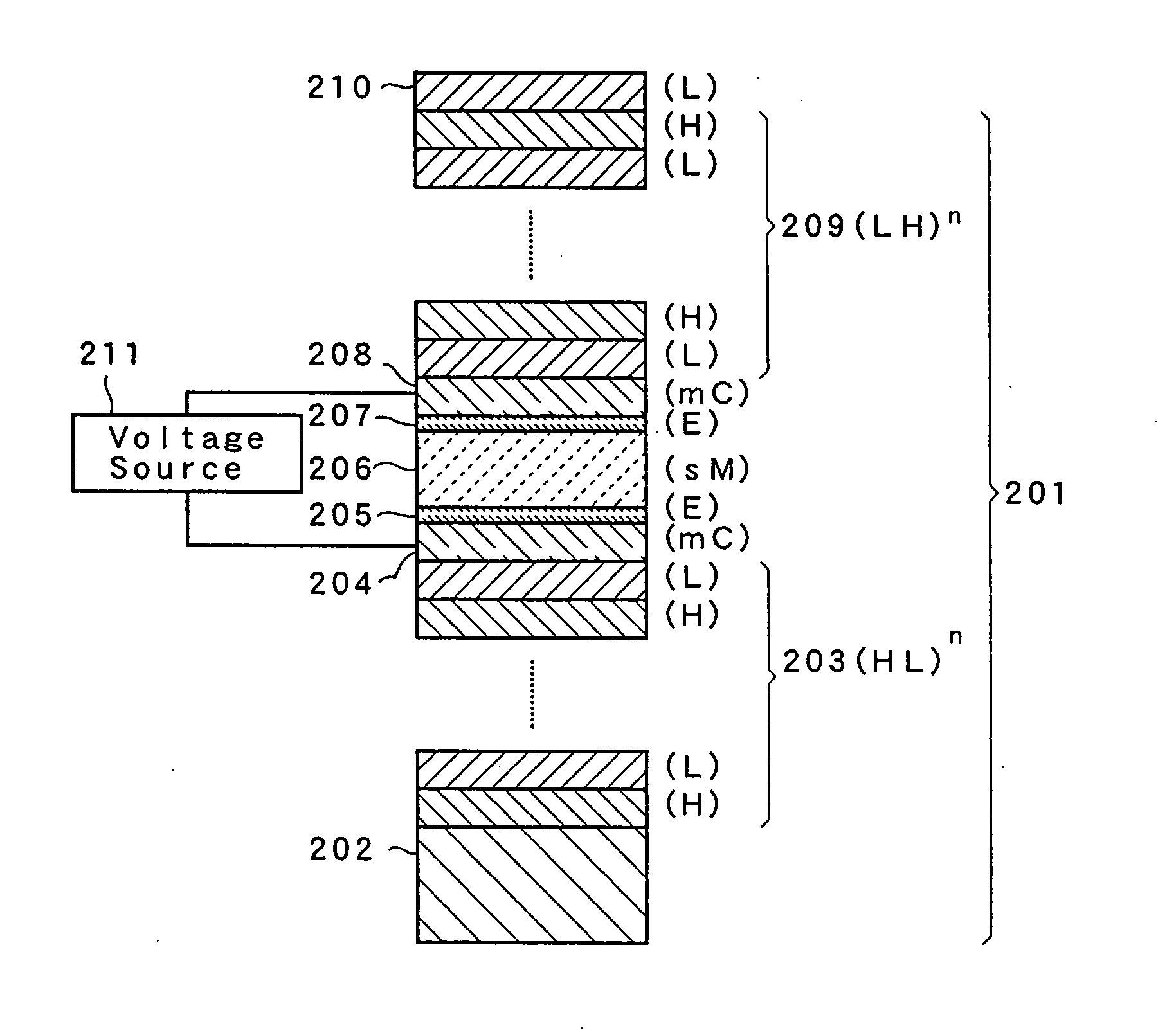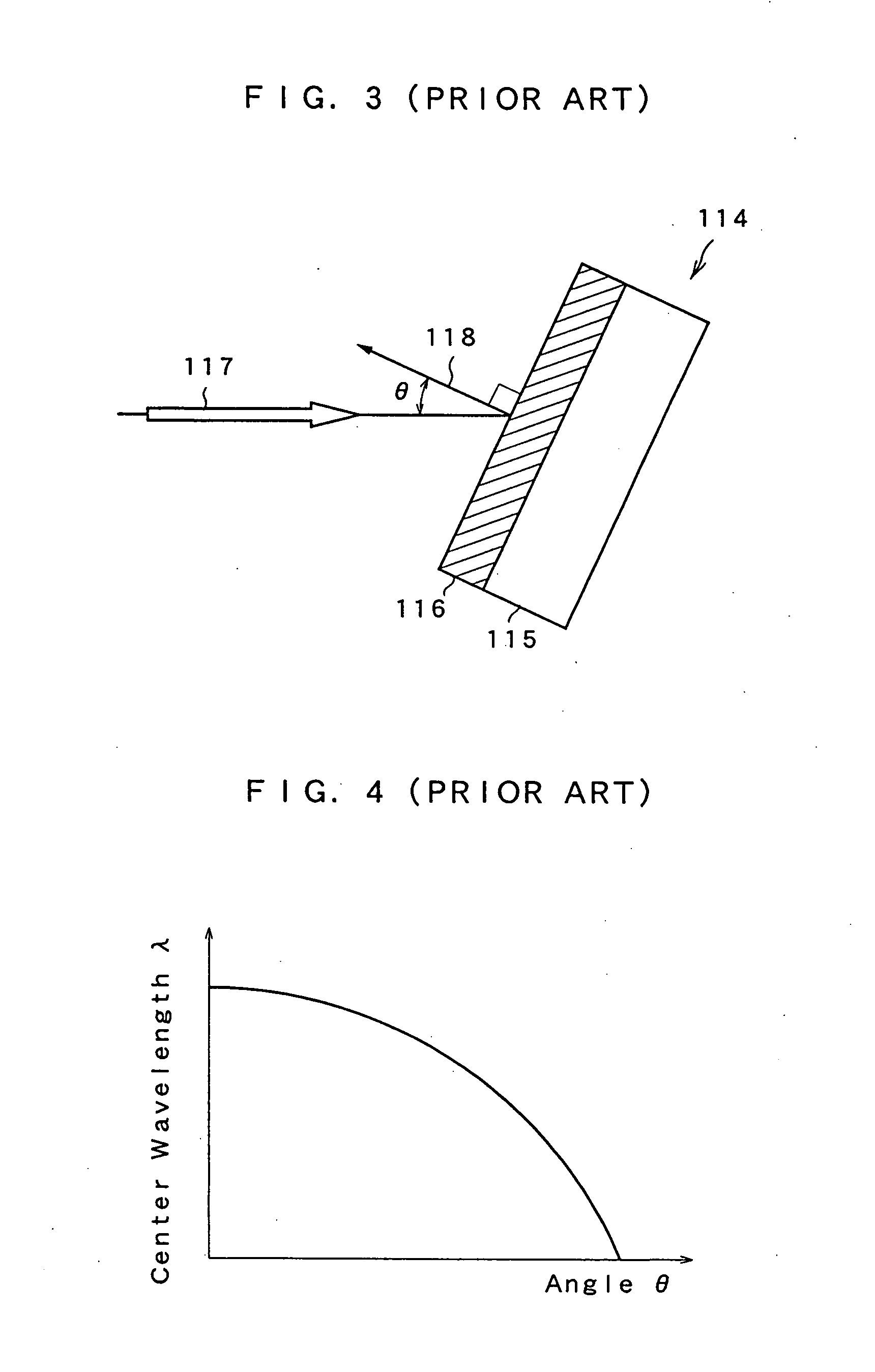Optical element, optical drop module, optical add-drop module, and tunable light source
a technology of optical drop module and optical drop module, which is applied in the field of optical drop module, optical adddrop module, and tunable light source, can solve the problems of high cost, high yield, and difficult control of the thickness of the multilayer film filter layer, and achieve high resistivity, improve the high-speed response property, and the effect of high resistivity
- Summary
- Abstract
- Description
- Claims
- Application Information
AI Technical Summary
Benefits of technology
Problems solved by technology
Method used
Image
Examples
first embodiment
[0092] The following description will discuss embodiments of the present invention. FIG. 8 shows a schematic cross-sectional structure of an optical element in accordance with a first embodiment of the present invention. This optical element 201 has a structure in that a first mirror stack layer 203 is formed on a substrate 202 with a first conductive thin film 204 being formed thereon. The first mirror stack layer 203 and the first conductive thin film 204 constitute a first composite stack layer. Then, a conductive buffer layer 205 is formed thereon, and a spacer layer 206, which is a dielectric thin film that exerts a primary electrooptic effect or a secondary electrooptic effect, and a conductive buffer layer 207 are further formed thereon. Moreover, a second composite stack layer, constituted by a second transparent conductive film 208 and a second mirror stack layer 209, is formed thereon. A coupling layer 210 is formed on the second mirror stack layer 209. The first transpare...
second embodiment
[0147] The following description will discuss an embodiment in which the above-mentioned optical element is practically applied to a bandpass filter, in detail. FIG. 10 shows a structure of a single cavity-type tunable bandpass filter in accordance with a second embodiment of the present invention. This single cavity-type tunable bandpass filter 301 of the present embodiment has a structure in that a first mirror stack layer 303 is formed on a substrate 302; a first transparent conductive film 304, a conductive buffer layer 305, a spacer layer 306, a conductive buffer layer 307 and a second transparent conductive film 308 are stacked thereon in succession; and a second mirror stack layer 309 is further placed thereon. A coupling layer 310 is placed on the second mirror stack layer 309. Holes 321 and 322, which reach the first transparent conductive film 304 and the second transparent conductive film 308 are formed through ion milling processes, etching processes and the like. A firs...
third embodiment
[0184]FIG. 19 shows an appearance of a double cavity-type tunable bandpass filter in accordance with the third embodiment of the present invention. This double cavity-type tunable bandpass filter 401 has a structure in that a first cavity 403 is formed on a glass substrate 402 made of MgO single crystal having a refractive index of 1.72 and a second cavity 404 is formed thereon. A coupling layer 405 is placed as the uppermost layer of the second cavity 404. First to fourth holes 4061 to 4064, each having a depth reaching an electrode (not shown) on respective layer, are formed in the surface of the coupling layer 405. One end of each of wires 4071 and 4072 for the first cavity is inserted to each of the first and second holes 4061 and 4062, and bonded to an electrode, not shown. The other end of each of the wires 4071 and 4072 for the first cavity is connected to a first voltage source 4081 for the first cavity 403. Moreover, one end of each of wires 4073 and 4074 for the second cav...
PUM
| Property | Measurement | Unit |
|---|---|---|
| thickness | aaaaa | aaaaa |
| resistivity | aaaaa | aaaaa |
| thickness | aaaaa | aaaaa |
Abstract
Description
Claims
Application Information
 Login to View More
Login to View More - R&D
- Intellectual Property
- Life Sciences
- Materials
- Tech Scout
- Unparalleled Data Quality
- Higher Quality Content
- 60% Fewer Hallucinations
Browse by: Latest US Patents, China's latest patents, Technical Efficacy Thesaurus, Application Domain, Technology Topic, Popular Technical Reports.
© 2025 PatSnap. All rights reserved.Legal|Privacy policy|Modern Slavery Act Transparency Statement|Sitemap|About US| Contact US: help@patsnap.com



